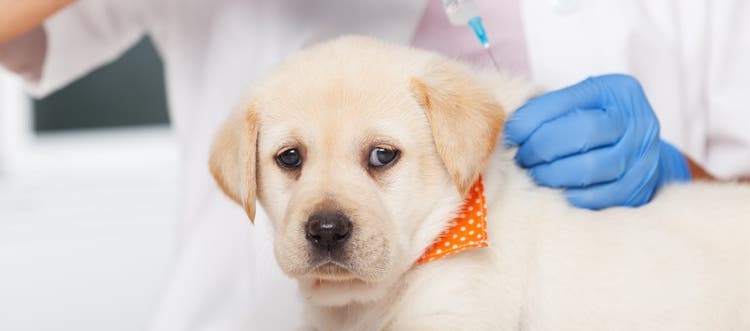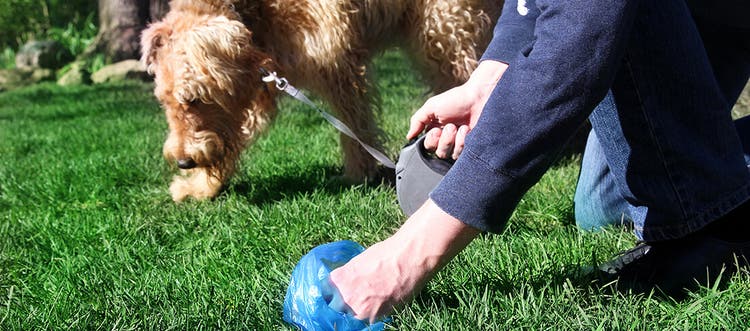Dog parks provide an excellent outlet for your dog to socialize. Here’s how to keep them safe while they mingle.
Aren’t dog parks the best? These public pup-friendly spots offer a wonderful opportunity for our dogs to socialize, exercise and have fun in a controlled and supervised environment. However, to make sure your pup has a tail-wagging good time, you’ll need to be aware of a few potential hazards and take some preventive measures.
From parasites and communicable diseases to heatstroke, other dogs and local wildlife, here’s how to plan for common safety concerns at your local dog park.
Dog Park Safety: How to Stay Clear of 4 Risks
Risk 1: Common Dog Parasites
According to a recent survey conducted by TRUE Global Intelligence of over 1,000 U.S. pet owners, COVID-19 restrictions have made our dogs more like members of the family than ever before.1 We’re spending more time with them and finding new ways to integrate them into our lives while we work from home, run errands and attend social activities.
But without proper care and preparation, all that socialization can have unintended consequences. A recently published study titled "Detection of Gastrointestinal Parasitism at Recreational Canine Sites in the United States" (the DOGPARCS study) found that in 85% of the parks sampled across 30 major metropolitan areas, at least one dog tested positive for intestinal parasites such as roundworm, whipworm, Giardia or hookworm. Out of over 3,000 samples collected, one in five had parasites.2 This culminates in an estimated 15 million dogs in the U.S. that could be unintentionally spreading parasites into the environment on any given day.2
The bottom line: Dog parks are a perfect environment for intestinal parasites to be deposited (aka pooped). Many of these parasites can survive in the environment for weeks or months, lying in wait until your dog snuffles them up. Not to mention the fleas or ticks your pup could encounter!
So, what can you do? First, take preventive measures to protect your dog. Regular veterinary check-ups and appropriate parasite control measures can significantly reduce the risk of infection. By taking a few proactive steps, your dog can continue to enjoy a healthy and safe social life.
To protect your dog from parasites:
- Make sure your dog is up to date on their flea and tick prevention treatments, as recommended by your veterinarian.
- Administer regular deworming medications to prevent intestinal parasites.
- After you visit the park, check your dog thoroughly for any signs of parasites, including bites or the insects themselves.
Keep in mind that even if your dog visits the vet every year, they may not be fully protected. The DOGPARCS study found that an estimated 40-52% of dogs remain completely unprotected from internal parasites, and less than half of dogs receive the recommended 12 months of protection each year.3,4
Risk 2: Dog Park Diseases
Dogs tend to interact closely at dog parks — how else do you properly make friends? — but these close encounters also leave them susceptible to communicable diseases. Regular vaccinations and routine vet visits can help safeguard your dog against illnesses like kennel cough, canine influenza and leptospirosis. Work closely with your vet to ensure your dog is up to date with their necessary vaccinations, tailored to their specific lifestyle and risk factors.
Additionally, a few good habits can help reduce the transmission of diseases at dog parks:
- Bring fresh water and a portable dog bowl from home — shared water sources can be a breeding ground for disease.
- Discourage your dog from eating feces or drinking from puddles to help prevent the spread of infections and pathogens.
- Be a good citizen! Clean up your dog’s poop and dispose of it properly.
Risk 3: Other Dogs and Local Wildlife
While your dog is practicing their zoomies or exploring smells along the fence line, keep a watchful eye out for aggressive dogs and wildlife. Dog-to-dog interactions can sometimes lead to conflicts, so it's essential to watch for body language cues and behavior.
Follow these tips to avoid potential conflicts:
- Be attentive to your dog's behavior and be ready to intervene if you notice signs of stress or discomfort.
- Follow all posted dog park rules and guidelines to help keep the peace.
- Always supervise your dog's interactions to ensure their safety and the safety of other dogs.
Risk 4: Heatstroke
Heatstroke is a serious concern, especially during hot weather or for certain breeds with reduced tolerance to heat, such as French bulldogs, cavalier King Charles spaniels and greyhounds.5
Taking these precautions can help your dog avoid heatstroke:
- Visit the dog park during the coolest parts of the day — typically the morning and evening.
- Provide plenty of fresh water to keep your dog hydrated.
- Check the outdoor temperature regularly, not just before you leave.
- Recognize heatstroke symptoms, such as excessive panting, drooling, lethargy and vomiting, and seek immediate veterinary attention if necessary.
Not All Dogs Are Cut Out for Parks
While dog parks are great for most dogs, certain dogs should avoid them for safety reasons. These include:
- Puppies: Young dogs are still developing and may not have received all their vaccinations, leaving them vulnerable to infections like parvo. It’s best to wait until your puppy is fully vaccinated before taking them to a dog park.
- Dogs with immunocompromised systems: These dogs are more susceptible to infections and communicable diseases. Consult your vet before considering a dog park visit.
Dog Park Safety Checklist: What to Pack
Heading to the dog park? Pack these essential safety-related items:
- Leash and collar: Always have a leash and collar handy for situations where leashing your dog becomes necessary. Check your local ordinances, as many locations require proof of a rabies vaccine.
- Fresh water: Carry a water bottle and a collapsible bowl to provide your dog with clean water during playtime.
- Waste bags: Clean up after your dog to maintain the park's cleanliness and hygiene.
- Towel or blanket: Bring a towel or blanket to provide shade and a cool resting spot for your dog.
- First-aid kit: Prepare a basic first-aid kit with items like antiseptic wipes, bandages and tweezers to address minor injuries.
By knowing the potential risks and practicing responsible pet ownership, you can make every trip to the dog park a fun and worry-free adventure for your beloved canine companion.
References
- TRUE Global Intelligence. Elanco COVID-19 Dog Socialization Survey. 25 June 2020.
- Stafford KS, Kollasch TM, Duncan KT, et al. Detection of Gastrointestinal Parasitism at Recreational Canine Sites in the United States (the DoGPaRCS study). Parasites & Vectors. 2020; 275:1-23.
- Cummings J, Vickers L, Marbaugh J. Evaluation of veterinary dispensing records to measure “clinic compliance” with recommended heartworm prevention programs. In: MD Soll, DH Knight (Eds.), Proceedings of the Heartworm Symposium ‘95, Batavia, IL: American Heartworm Society, 183-186.
- Gates MC, Nolan TJ. Factors influencing heartworm, flea, and tick preventative use in patients presenting to a veterinary teaching hospital. Prev Vet Med. 2010;93 (2-3):193-200.
- Hall EJ, Carter AJ, O’Neill DG. Incidence and risk factors for heat-related illness (heatstroke) in UK dogs under primary veterinary care in 2016. Scientific Reports. 2020. https://www.nature.com/articles/s41598-020-66015-8.




